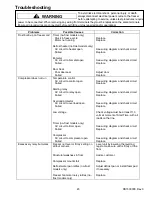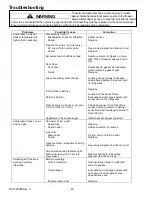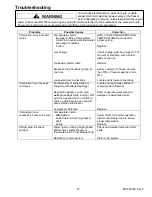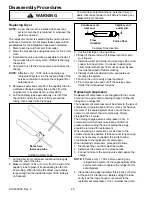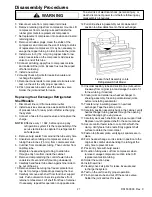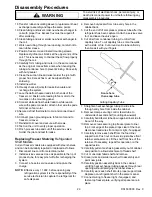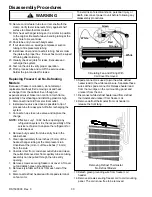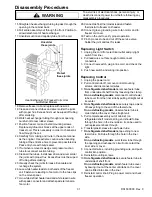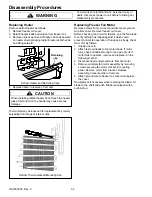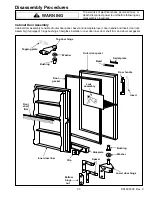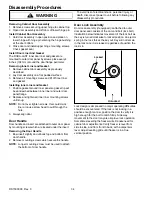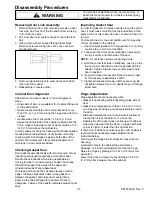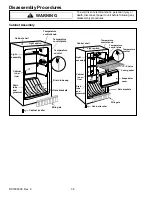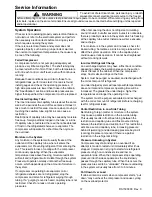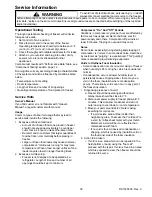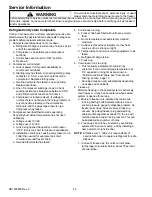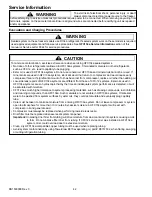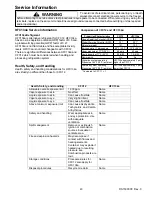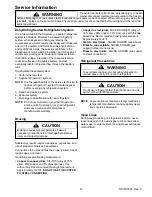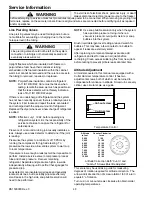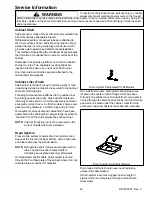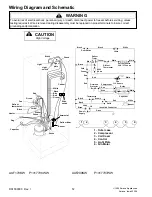
37
RS1500000 Rev. 0
Service Information
To avoid risk of electrical shock, personal injury, or death,
always disconnect electrical power source to the freezer
before attempting to service unless test procedures require power to be connected. When removing any wiring from
terminals, replace on the same terminals. Ensure all ground wires are connected before certifying unit as repaired
and/or operational.
WARNING
!
System Operation
If freezer is not operating properly and electrical failure is
not ruled out, refer to the electrical system and perform
the necessary electrical tests before making any test
which requires opening the system.
If there is no electrical failure and system does not
operate properly, such as long run periods or warmer
than normal compartment temperatures, the cause may
be one of the following.
Failed Compressor
A compressor which is not pumping adequately will
produce very little cooling effect. The shelf tubing may
be covered with a thin film of frost, but the temperature
will not reach control cut-off level, even with continuous
running.
Because these conditions are similar to those for a
refrigerant leak, perform leak test. If no leak is found,
install gauges and check the operating pressures. If
high side pressures are lower than those in the table in
the Specification section and low side pressures are
higher than specified, the compressor must be replaced.
Restricted Capillary Tube
The inner diameter of a capillary tube is about the same
size as the period at the end of this sentence. It doesnt
take much to restrict this area. Use care when moving or
touching the capillary tube, slight kink can cause a
restriction.
Restrictions of capillary tube may be caused by moisture
freeze-up, foreign particles lodged in the tube, or a kink.
If capillary tube is restricted, there will be noticeable lack
of frost on the refrigerated shelves or evaporator. The
compressor will operate for a short time then cycle on
the overload.
Moisture in the System
Any moisture in the system will usually freeze at the
outlet end of the capillary tube, where it enters the
evaporator coil. Preventing refrigerant from entering the
coil. This results in loss of cooling with the compressor
continuously operating. When the evaporator
temperature rises above freezing, moisture restriction
will melt and refrigerant will circulate through the system.
Freezer will operate normally until another freeze-up
occurs, which depends upon the amount of moisture in
the system.
If compressor is operating but evaporator coil or
refrigerated shelves are not refrigerated, stop the
compressor and listen for refrigerant surging through
tubing. If a gurgling sound is heard, capillary tube is not
restricted. Check for a leak or check operating
pressures.
When first opening the door no refrigerant circulating
sound is heard, but after several minutes it is noticeable,
there is probably moisture in the system which is freezing
at the capillary tube outlet. Install a new drier, evacuate,
and recharge.
If no moisture is in the system and no leaks, check for
kinked tubing. Sometimes a kink in a large tube will not
affect the system operation. Kink in the capillary tube
could cause erratic operation. It cannot be straightened
without cracking its walls.
Incorrect Refrigerant Charge
An overcharged system may have a frost back condition
appearing outside the insulation sleeve on the suction
line at the rear of the cabinet. When the compressor
stops, frost melts and drips on the floor.
System must be purged, evacuated, and recharged with
the correct amount of refrigerant.
An undercharged system will operate with temperatures
above normal and compressor operating time will be
increased. The greater the undercharge, higher the
temperatures and longer the operating time.
The system must be purged, evacuated, and recharged
with the correct amount of refrigerant. Before recharging,
test for refrigerant leaks.
Partial Restriction in Low Side Tubing
Bent tubing, foreign matter, or moisture in the system,
may cause a partial restriction in the low side tubing.
This usually results in frost-free tubing between the
restriction and capillary tube and frost-covered tubing
between the restriction and suction line. This restrictions
acts like a second capillary tube, increasing pressure
behind it (warming) and decreasing pressure beyond it
(cooling). Replace component if there is a partial
restriction in the refrigerant tubing.
Pressure Unloading in System
Compressor may stall and cycle on overload if an
attempt is made to restart unit immediately after it has
stopped. Compressor is trying to start while refrigerant
pressure is high on condenser side and low on
evaporator side. When the compressor stops operating,
pressure in both sides equalizes as the liquid slowly
passes through the capillary tube. When this occurs the
pressures are said to be unloaded. Pressure unloading
in the system will usually take from 3 to 6 minutes.
Pull Down Over Load
If cabinet interior is warm when compressor starts, pull
down may overheat the compressor and cause cycling
on the overload protector.

